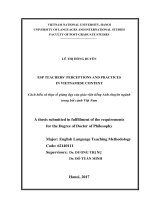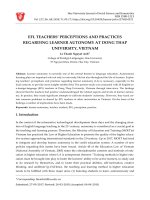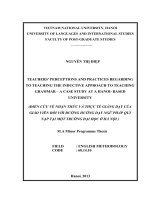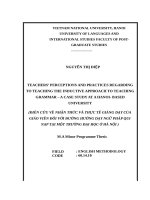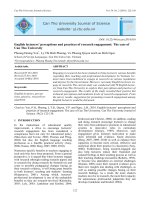Efl teachers’ perceptions and practices of enacting the communication skill section in pre intermediate voices coursebook at quy nhon university
Bạn đang xem bản rút gọn của tài liệu. Xem và tải ngay bản đầy đủ của tài liệu tại đây (1.46 MB, 95 trang )
MINISTRY OF EDUCATION AND TRAINING
QUY NHON UNIVERSITY
NGUYEN THI TU LINH
EFL TEACHERS’ PERCEPTIONS AND PRACTICES OF
ENACTING THE COMMUNICATION SKILL SECTION
IN PRE-INTERMEDIATE VOICES COURSEBOOK
AT QUY NHON UNIVERSITY
Field: Theory and Methodology of English Language Teaching
Code: 8140111
Supervisor: Ha Thanh Hai, Ph.D
Binh Dinh - 2023
BỘ GIÁO DỤC VÀ ĐÀO TẠO
TRƯỜNG ĐẠI HỌC QUY NHƠN
NGUYỄN THỊ TÚ LINH
NHẬN THỨC VÀ VIỆC THỰC HÀNH GIẢNG DẠY
MỤC COMMUNICATION SKILL TRONG GIÁO TRÌNH
PRE-INTERMEDIATE VOICES CỦA GIẢNG VIÊN
TRƯỜNG ĐẠI HỌC QUY NHƠN
Ngành: Lý luận và phương pháp dạy học bộ môn tiếng Anh
Mã số: 8140111
Người hướng dẫn: TS. Hà Thanh Hải
Bình Định - 2023
i
DECLARATION OF AUTHORSHIP
The research study, entitled "EFL Teachers' Perceptions and Practices of
Enacting the Communication Skill Section in Pre-Intermediate Voices
Coursebook at Quy Nhon University," was conducted with the guidance of Dr.
Ha Thanh Hai, an esteemed lecturer at Quy Nhon University.
I declare that all the information reported in this study is the outcome of
my independent research efforts. The materials referenced in this study are
diligently acknowledged, and no other sources have been utilized without proper
attribution within the main body of the thesis. It is crucial to note that this thesis
has not been previously submitted, either partially or in its entirety, for the
purpose of obtaining any other academic degree or diploma.
Binh Dinh, 2023
Nguyen Thi Tu Linh
ii
ACKNOWLEDGEMENTS
The completion of my master's thesis has been made possible by the invaluable
support, guidance, and contributions of numerous individuals. I am deeply
grateful to each and every one of them for their unwavering dedication and
assistance throughout this research endeavor.
First and foremost, I would like to express my sincere appreciation to my thesis
supervisor, Dr. Ha Thanh Hai. His expertise, dedication, and invaluable guidance
have been crucial in shaping the direction and quality of this research. I am
immensely grateful for his mentorship, constructive feedback, and support
throughout the entire process.
Furthermore, in addition to the aforementioned individuals, I would also like to
extend my heartfelt thanks to the lecturers in the Foreign Language Department
who graciously participated as respondents in this study. Their willingness to
share their insights, experiences, and expertise has provided the necessary data
and enriched the depth of this research.
Moreover, I am deeply grateful for the unwavering support of my parents and the
unwavering encouragement of my friends. Their presence and assistance have
been invaluable throughout this thesis, shaping both my personal and academic
growth.
Last but not least, I would like to extend my appreciation to all those who have
supported me in various ways during the course of this thesis. Your words of
encouragement, belief in my abilities, and acts of kindness have been immensely
meaningful and have motivated me to overcome obstacles.
iii
ABSTRACT
This study aimed to investigate EFL teachers’ perceptions and practices of
enacting the communication skill section in Pre-Intermediate Voices coursebook.
To fulfill the aim, the study was carried out at Quy Nhon University with the
enthusiastic participation of 20 English teachers. The data for the study was
collected through teachers’ questionnaires, semi-structured interview, and
classroom observations, and then analyzed both quantitatively and qualitatively.
The findings of the study revealed that (1) the teachers’ perceptions regarding
the use of the communication skill section in improving students’ sociolinguistic
competence, strategic competence, and pronunciation and vocabulary aspect of
linguistics competence in the communication skill section were moderately
positive. Specifically, they were in favor of the use of sociolinguistic and
strategic competence in speaking classrooms as it significantly contributed to
improving their students’ speaking performance. (2) Teachers implemented
different practices to enhance communicative competence, including activities to
develop linguistic, sociolinguistic, and strategic competence. They focused on
speaking through interactive tasks like group works, pair works, games, role-
plays and discussions in the speaking teaching cycle. (3) Based on the data
obtained, there is a correlation between teachers' perceptions and practices of the
communication skill section. Positive perceptions aligned with implementation
of practices targeting different aspects of communication skills. However, there
may be some discrepancy in improving discourse competence, as perceptions
were neutral in that area.
iv
TABLE OF CONTENTS
DECLARATION OF AUTHORSHIP ........................................................... i
ACKNOWLEDGEMENTS............................................................................ ii
ABSTRACT ....................................................................................................iii
TABLE OF CONTENTS............................................................................... iv
LIST OF ABBREVIATION.........................................................................vii
LIST OF TABLES .......................................................................................viii
LIST OF FIGURE.......................................................................................... ix
CHAPTER 1. INTRODUCTION .................................................................. 1
1.1 Rationale .................................................................................................. 1
1.2. Aims and objectives ................................................................................ 4
1.2.1. Aims ......................................................................................................4
1.2.2. Objectives..............................................................................................4
1.3. Research questions.................................................................................. 4
1.4. Scope of the study ................................................................................... 4
1.5. Significance of the study......................................................................... 6
1.6. Organization of the study........................................................................ 7
CHAPTER 2. LITERATURE REVIEW ...................................................... 9
2.1. Communication Skills............................................................................. 9
2.2. Communicative language teaching method .......................................... 13
2.3. Teaching speaking skills ....................................................................... 16
2.3.1. Characteristics of speaking performance ............................................16
2.3.1.1. Linguistic knowledge..................................................................16
2.3.1.2. Core speaking skills ....................................................................17
2.3.1.3. Communication strategies...........................................................18
2.3.2. A Teaching-Speaking Cycle ...............................................................19
2.3.3. Speaking activities in EFL classroom .................................................23
2.3.3.1. Role-play .....................................................................................24
v
2.3.3.2. Group work .................................................................................24
2.3.3.3. Pair work .....................................................................................25
2.3.3.4. Interviews/ Talk shows ...............................................................25
2.3.3.5. Games..........................................................................................26
2.3.3.6. Debate .........................................................................................26
2.3.3.7. Storytelling..................................................................................27
2.4. The role of teachers and coursebooks in speaking classrooms ............ 27
2.5. Previous related studies......................................................................... 29
CHAPTER 3. RESEARCH METHODOLOGY........................................ 32
3.1. Research design .................................................................................... 32
3.2. Research setting and participants.......................................................... 33
3.3. Research instruments ............................................................................ 34
3.3.1. Observation .........................................................................................35
3.3.2. Questionnaire ......................................................................................35
3.3.3. Semi-structured interview ...................................................................37
3.4. Data collection procedures.................................................................... 38
3.5. Data analysis procedures....................................................................... 38
3.6. Research reliability and validity ........................................................... 39
3.7. Ethical considerations ........................................................................... 39
CHAPTER 4 . FINDINGS AND DISCUSSION ........................................ 40
4.1. Teachers’ perceptions of enacting the communication skill section in
Pre-Intermediate Voices coursebook ........................................................... 40
4.1.1. Teachers’ perceptions of the language learning definition .................41
4.1.2. Teachers’ perceptions of the linguistic competence realized in the
communication skill section..........................................................................43
4.1.3 Teachers’ perceptions of the sociolinguistic competence realized in the
communication skill section..........................................................................47
4.1.4 Teachers’ perceptions of the discourse competence realized in the
communication skill section..........................................................................49
vi
4.1.5 Teachers’ perceptions of the strategic competence realized in the
communication skill section..........................................................................51
4.2. Teachers’ practices of enacting the communication skill section in Pre-
Intermediate Voices coursebook.................................................................. 53
4.2.1. Focus learners’ attention on speaking.................................................53
4.2.2. Provide input and guide planning .......................................................55
4.2.3. Conduct speaking tasks.......................................................................57
4.2.4. Focus on language/skills/strategies.....................................................58
4.2.5. Repeat speaking tasks .........................................................................60
4.2.6. Direct learners’ reflection on learning ................................................62
4.2.7. Facilitate feedback on learning ...........................................................63
4.3. Teachers’ perceptions and their actual classroom practices regarding
enacting the communication skill section in the Pre-Intermediate Voices
coursebook ................................................................................................... 64
CHAPTER 5. CONCLUSION AND IMPLICATIONS ............................ 68
5.1. Conclusion ............................................................................................ 68
5.2. Pedagogical implications ...................................................................... 70
5.3. Limitations ............................................................................................ 71
5.4. Recommendations and suggestion for further research........................ 72
REFERENCES .............................................................................................. 71
APPENDICES ................................................................................................. 1
APPENDIX A. QUESTIONNAIRE .............................................................. 1
APPENDIX B: QUESTIONS FOR SEMI-STRUCTURED INTERVIEW
........................................................................................................................... 4
APPENDIX C: CLASSROOM OBSERVATION CHECKLIST .............. 5
vii
LIST OF ABBREVIATION
CLT: Communication Language Teaching
EFL: English as a Foreign Language
viii
LIST OF TABLES
Table 3.1. Research questions and instruments ......................................... 34
Table 4.1. Teachers’ perceptions of the language learning definition ..... 42
Table 4.2. Teachers’ perceptions of the linguistic competence realized in
the communication skill section ................................................................... 44
Table 4.3. Teachers’ perceptions of the sociolinguistic competence
realized in the communication skill section ................................................ 47
Table 4.4. Teachers’ perceptions of the discourse competence realized in
the communication skill section ................................................................... 49
Table 4.5. Teachers’ perceptions of the strategic competence realized in
the communication skill section ................................................................... 51
ix
LIST OF FIGURE
Figure 1. The Teaching-Speaking Cycle (Goh & Burns, 2012, p.153) ..... 20
1
CHAPTER 1
INTRODUCTION
This chapter provides an explanation for the study and outlines the main
elements of the thesis. It begins by presenting the key reasons for conducting the
study. The objectives of the thesis are then stated and further clarified through
research questions. The chapter also discusses the extent and importance of the
current study. It concludes by describing how the thesis is organized.
1.1 Rationale
In today's world, teaching communication skills in the context of English
education is extremely important. English is widely used for global
communication, and being proficient in it provides many opportunities. By
teaching communication skills, teachers help students navigate diverse
environments and express themselves clearly. Developing these skills also
encourages critical thinking, creativity, and empathy, preparing students to
succeed in our interconnected society. According to Nazari (2005), teachers'
perceptions of teaching communication skills in the context of English education
hold significant weight in today's educational landscape. As key facilitators of
learning, teachers play a crucial role in shaping students' language acquisition
and communication abilities. Their understanding of the importance of
communication skills influences their instructional strategies, curriculum design,
and assessment methods. Yufrizal (2017) suggested that by recognizing the
value of fostering effective communication, teachers can create a supportive and
engaging learning environment that nurtures students' language proficiency and
confidence. Moreover, Chand (2022) reported that teachers who prioritize
communication skills are better equipped to adapt their teaching approaches to
meet the evolving needs and demands of the modern world. By valuing and
2
prioritizing the teaching of communication skills, educators contribute to
equipping students with the tools they need to thrive in an interconnected and
linguistically diverse society.
One specific aspect of communication skills that holds immense
importance in English education is the teaching of oral communication or
speaking. Oral communication serves as a cornerstone for effective
interpersonal interaction and understanding. Furthermore, research conducted
on spoken language corpora, such as the CANCODE spoken corpus analyzed
by McCarthy and Carter (1995), has presented substantial evidence of notable
distinctions between spoken and written English and the implications for
pedagogy (Carter, 1998, as cited in Renandya & Widodo, 2016). This
highlights the necessity for a teaching methodology that goes beyond a solely
text-based approach to ensure that second language (L2) learners acquire a
natural command of English that accurately reflects real-life spoken usage
(McCarthy and Carter, 2001, as cited in Renandya & Widodo, 2016). This
viewpoint is also shared by practitioners such as Goh (2009) and Timmis
(2005). By focusing on developing speaking skills, teachers empower students
to express their thoughts, ideas, and emotions with clarity and confidence.
This proficiency in spoken English not only enhances students' ability to
engage in meaningful conversations but also equips them with the necessary
skills to navigate real-life situations, such as interviews, presentations, and
group discussions. Moreover, teaching speaking skills cultivates active
listening, critical thinking, and effective expression, enabling students to
become effective communicators in various professional and social contexts.
By emphasizing the teaching of oral communication skills, educators provide
students with a valuable toolset that extends beyond language proficiency and
prepares them for success in their personal and professional lives.
In that given context, it is crucial to foster effective communication
proficiency among learners of English as a foreign language, recognizing that
3
acquiring proficiency in a foreign language is neither simple nor effortless.
Indeed, researchers have investigated various instructional approaches in order to
identify an effective method for teaching and learning English speaking skills in
ESL classrooms. Numerous researchers globally (Nishino, 2011; Adem,
Berkessa, 2022) strongly advocate that teachers' perceptions of teaching
speaking skills should align with their classroom practices. Since the
introduction of the communicative language teaching approach (CLT) in the
1970s, many English instructors have embraced this approach to facilitate the
development of higher-quality speaking skills among students. According to
Nishino (2011), teachers consider a change in classroom conditions to be a
prerequisite for implementing CLT in their teaching. However, as highlighted by
Adem, Berkessa (2022), while the teachers employed similar major activities and
teaching cycles, many of their actual classroom practices did not align with the
principles of Communicative Language Teaching. Various factors, including
those related to the learners, influenced the teachers' implementation of CLT
principles and their overall approach to teaching speaking skills.
Despite the increasing amount of research on the influence of teachers'
beliefs on teaching speaking skills (Gandeel, 2016; Webster, 2019), there has
been limited prior investigation into teachers' perspectives and implementation
of the communication skill section in coursebooks. In Vietnam, some studies
have explored teachers' perceptions of teaching speaking skills at the high school
level (Mai, 2016; Thai, Nguyen, 2022). However, there is a lack of research
addressing the disparity between teachers' perceptions and their actual classroom
practices regarding the materials used at the tertiary level. Therefore, conducting
further research to gain insights into teachers' perceptions and practices is crucial
for a better understanding of the utilization of materials in teaching speaking
skills, particularly in tertiary education settings.
Based on the aforementioned factors, the writer has been motivated to
select the topic "EFL Teachers' Perceptions and Practices of Enacting the
4
Communication Skill Section in the Pre-Intermediate Voices Coursebook at Quy
Nhon University" for my M.A. thesis. The anticipated outcomes of the study aim
to offer valuable insights and pedagogical suggestions that can contribute to the
improvement of teaching speaking skills in the L2 context, benefiting both
teachers and students in achieving more effective instructional outcomes.
1.2. Aims and objectives
1.2.1. Aims
The aim of this study is to investigate EFL teachers’ perceptions and
practices of enacting the communication skill section in Pre-Intermediate Voices
coursebook at Quy Nhon University.
1.2.2. Objectives
The objectives of this study are the followings:
- To examine EFL teachers’ perceptions of enacting the communication
skill section in Pre-Intermediate Voices coursebook at Quy Nhon
University.
- To explore EFL teachers’ practices of enacting the communication
skill section in Pre-Intermediate Voices coursebook at Quy Nhon
University.
1.3. Research questions
In order to fulfill the above aim and objectives, the researcher gathered
data and examined it to provide answers to the following two questions:
1. What are EFL teachers’ perceptions of enacting the communication skill
section in Pre-Intermediate Voices coursebook at Quy Nhon University?
2. What are EFL teachers’ practices of enacting the communication skill
section in Pre-Intermediate Voices coursebook at Quy Nhon University?
1.4. Scope of the study
The focus of this study is limited to discovering about how the
5
communication skill section of the Pre-Intermediate Voices coursebook is now
implemented at Quy Nhon University and how teachers perceive this
implementation in light of time, ability, and data availability constraints.
Additionally, only foreign language teachers were eligible to participate in this
survey. As stated above, the study is restricted to the area of exploring teachers’
perceptions and practices of enacting the communication skill section in Pre-
Intermediate Voices coursebook. Specifically, the researcher identifies teachers’
general perceptions of the communication skill section and some difficulties they
might face enacting this section.
Voices is a comprehensive program designed for adult and young adult
learners, offering seven levels of instruction that cover various skills.
Specifically, at Quy Nhon University, Pre-Intermediate Voices is used for non-
English students. It equips instructors with the necessary tools and confidence to
teach effectively in any classroom setting. With a logical lesson progression and
the added support of The Voices Professional Development Video Collection,
teachers have access to a wide range of materials for engaging courses, whether
conducted online or in-person. Through the program, learners enhance their
English language abilities by immersing themselves in the experiences of
National Geographic Explorers, who serve as relatable role models within the
global English community. They engage in thought-provoking scenarios that
reflect culturally diverse situations, allowing them to practice the essential
communication skills required to navigate social interactions in English.
Moreover, the program emphasizes practical pronunciation techniques, ensuring
learners develop clear and easily understandable speaking skills.
Besides, teachers’ practices of enacting the communication skill section
are extensively investigated. Then, the similarities and differences between their
perceptions and practices were also discussed. Based on the findings, some
suggestions were given to help the teachers improve the implementation of
enacting the communication skill section in Pre-Intermediate Voices coursebook
6
to the fullest, which might promote students' enjoyment of learning and their
academic performance. The study limits its scope to the participation of 20
teachers at the Department of Foreign Languages, Quy Nhon University. The
justification for choosing participants is that they are assumed to be similar in
terms of required proficiency level and background knowledge of English. Those
teachers have taught English 1, so they fully could be familiar with the
communication skill section in Pre-Intermediate Voices coursebook. Secondly,
in the second term of the school year 2022-2023, some of them have been
teaching English 2, in which they taught the communication skill section in Pre-
Intermediate Voices coursebook.
1.5. Significance of the study
Although numerous studies have been conducted on communication
skills, there is a limited focus on examining teachers' perceptions and practices
regarding the communication skill section in a coursebook at the tertiary level.
Consequently, this study is undertaken with the aim of providing valuable
insights to EFL instructors in their teaching of speaking skills. The findings of
the study are expected to assist teachers in gaining a deeper understanding of the
challenges or obstacles they encounter when delivering the communication skill
section of instruction. By recognizing these issues, teachers can make
adjustments to their implementation of the communication skill component,
thereby enhancing the effectiveness of the teaching and learning process. From
an educational standpoint, this study holds significance both in theoretical and
practical terms.
In terms of theory, the study contributes to the teaching theories regarding
the communication skill section in the alignment between what the teachers
perceive and what they really practice.
In terms of practice, the findings of this study may benefit English
teachers, students, and researchers. As for the teachers, the findings of the study
7
could raise teachers’ awareness of what they perceive the use of the
communication skill section in Pre-Intermediate Voices coursebook in
classrooms. As a consequence, they will endeavor to implement it in an effective
way so that their students can improve their speaking performance. This study
can also be used as a reference, not only by English teachers at Quy Nhon
University but also by teachers who want to employ the communication section
in Pre-Intermediate Voices coursebook. In addition, they might figure out how to
bridge the gap between their perceptions of enacting the communication skill
section and their classroom practices. For students, this study hopes to help them
realize the importance of communication competence and some problems may
arise, which can give them negative perceptions. Finally, with regard to the
researchers, those who share the same interest in this topic could certainly rely
on this research to find reliable and useful references for their related studies.
1.6. Organization of the study
The thesis consists of five chapters.
Chapter 1, Introduction, present the rationale, the aims and objectives, the scope,
the research questions, the significance, and the structure of the study.
Chapter 2, Literature Review, defines major related concepts and briefly review
the related works that compose the theoretical background of the study.
Chapter 3, Research Methodology, deals with research methodologies, data
description, data analysis, and research procedures. The data’s reliability and
validity are also discussed in this chapter.
Chapter 4, Findings and Discussion, describes the analysis of data in detail and
gives a summary of the findings as well as a thorough discussion of the findings
of the study. Some explanations and interpretations of the findings are also
presented in this chapter.
Chapter 5, Conclusion, summarizes the whole research, gives some teaching
8
implications, and discusses the limitations of the study, as well as suggestions
for further research.
9
CHAPTER 2
LITERATURE REVIEW
This chapter introduces and situates the theoretical framework of the thesis
within the pertinent research field. The chapter is divided into four sections, each
covering different aspects. The first section focuses on communication skills,
followed by an exploration of the communicative language teaching method.
The third section delves into the topic of teaching speaking skills, while the final
section discusses the roles of teachers and coursebooks in the English speaking
classroom.
2.1. Communication Skills
In the contemporary global landscape, effective communication is
essential for achieving success in any field. Language serves as the primary
means of communication, and effective communication relies on the use of
language. Without language, achieving flawless communication is unattainable.
Moreover, individuals cannot fulfill their aspirations, objectives, or goals
without the ability to communicate effectively.
2.1.1. Spoken and Written Communication
There are two fundamental forms of communication: Spoken
communication and Written communication. Spoken communication entails the
verbal and visual transmission of information from one person to another. It is
influenced by various factors, including social, institutional, psychological, and
linguistic elements. Examples of oral communication include presentations,
speeches, and dialogues. Spoken communication can be achieved through a
variety of methods. It is crucial that the words are appropriately structured and
delivered with the appropriate pitch and tone. A successful method of oral
communication must possess clarity, conciseness, and accuracy. To ensure that


